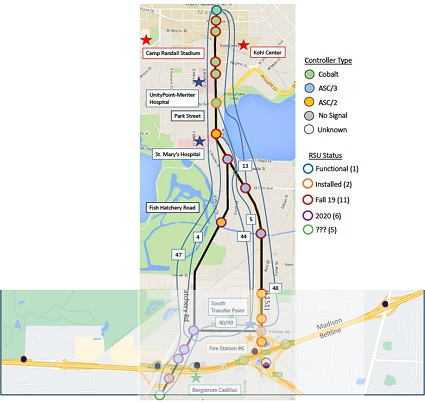The Traffic Operations and Safety Laboratory (TOPS Lab) at UW-Madison, in partnership with the city of Madison and TAPCO, a Brown Deer-based traffic safety equipment manufacturer and service provider, has created Wisconsin’s first connected corridor along Park Street in Madison.
Fifteen intersections along the Park Street corridor now have dual-band dedicated short-range communication (DSRC) roadside units (RSU) that can “talk” to vehicles that have appropriate test equipment as they move through the corridor.
As the vehicles move, they transmit basic safety messages (BSMs) about speed, location and direction of traffic. The intersection is sending back information on signal phasing and timing, often referred to as SPAT messaging. For example, if the traffic signal is red, it informs the vehicle that the light is red, as well as how soon the signal will turn green.
The connected vehicle infrastructure also sends out support messages such as a map of the intersection, so a connected vehicle knows what lane it’s in and whether that lane is used for turning. The Madison Park Street project is valuable not only as a means to collect data in a real-world connected corridor, but to provide the department and researchers opportunities to use that data to explore how to improve traffic safety and flow.
Though cars capable of interfacing with connected infrastructure are uncommon now, these pilot projects provide invaluable information as we prepare for the day connected and automated technologies become more broadly available.
The Park Street connected corridor is the first of its type in the state.
BTO (WisDOT Bureau of Traffic Operations) CV Pilot Project – Phase 3
The Wisconsin Department of Transportation is working with the UW TOPS Lab to expand the Park Street project along two interchanges on Highway 12/18 to capture traffic flow information on Highway 12/18 and integrate the sharing of data between the city system and the state system.
- Integrates and extends the Madison's Park Street Connected Corridor
- Includes MMITSS integration
- WisDOT locations
- Madison Beltline Interchange with Park St (USH 151)
- Madison Beltline Interchange with Fish Hatchery Rd
- Installed and integrated 6 RSUs (roadside radio units)